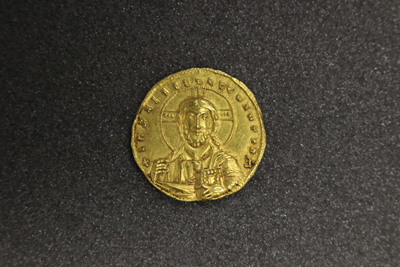‘Byzantium’ celebrates a golden age of coinage
 A new exhibition, now open at the Hunterian Museum, reveals the fascinating coinage of the Byzantine Empire.
A new exhibition, now open at the Hunterian Museum, reveals the fascinating coinage of the Byzantine Empire.
Byzantium: A Golden Age of Coinage, is the first exhibition of its kind at The Hunterian and showcases over 150 rare gold, silver and base metal coins from the Byzantine era (4th – 5th centuries CE).
The exhibition tells the story of this turbulent period through its coinage, examining its origins, religion, conflicts, decline and legacy.
For a thousand years, the Byzantine Empire dominated the eastern Mediterranean. Centred on the capital of Constantinople, it was a beacon of Roman power, Greek influence and Christian worship, which spanned the ancient and medieval worlds.
A succession of emperors and empresses directed civil, military and religious affairs within ever shifting borders. Coins bearing their images were struck at mints across the Empire, and the exhibition includes a number of examples, reflecting dramatic periods of history and a golden era of coinage from an extraordinary civilisation.
A huge variety of gold and base metal denominations were produced by Byzantine mints. Silver was less common. Gold underpinned the Byzantine economy, trade and taxation, with the solidus and histamenon nomisma maintaining their weight and fineness almost continuously until the early 11th century. These coins became the dominant currency not only within the borders of the empire, but also in neighbouring territories.
All of the items on display come from The Hunterian coin collection, which is considered one of the best in the world.
Byzantium: A Golden Age of Coinage is at the Hunterian Museum until 21 May 2019. Admission is free.
Hunterian Museum
University of Glasgow
Gilbert Scott Building
Glasgow G12 8QQ
Open Tuesday – Saturday 10.00am – 5.00pm and Sunday 11.00am – 4.00pm
Admission free
glasgow.ac.uk/hunterian
Image: Nicephorus II, histamenon nomisma, 963 – 969, gold, Constantinople.
Further Information
For further information contact:
Jesper Ericsson, Curatorial Assistant: Coin Room, The Hunterian
For images contact:
Harriet Gaston, Communications Manager, The Hunterian
Alternatively, download images from our press image section
Notes to Editors
The Hunterian houses one of the world’s great coin collections, containing 80,000 coins, medals, tokens and related objects.
About 30,000 come from the original collection of Dr William Hunter put together at the end of the 18th century, when it was second only in importance to the French Royal Collection. Today it is Scotland’s premier collection in this subject.
The collection contains Ancient Greek, Roman, Medieval and Modern coins as well as medals from the Renaissance to contemporary Scotland. Many of these are unique or extremely rare and most are in superb condition.
The Hunterian
The Hunterian is one of the world's leading University museums and one of Scotland’s greatest cultural assets. Built on Dr William Hunter’s founding bequest, The Hunterian collections include scientific instruments used by James Watt, Joseph Lister and Lord Kelvin; outstanding Roman artefacts from the Antonine Wall; major natural and life sciences holdings; Hunter’s own extensive anatomical teaching collection; one of the world’s greatest numismatic collections and impressive ethnographic objects from Captain Cook’s Pacific voyages.
The Hunterian is also home to one of the most distinguished public art collections in Scotland and features the world’s largest permanent display of the work of James McNeill Whistler, the largest single holding of the work of Scottish artist, architect and designer Charles Rennie Mackintosh (1868–1928) and The Mackintosh House, the reassembled interiors from his Glasgow home.
glasgow.ac.uk/hunterian
First published: 1 January 2019

